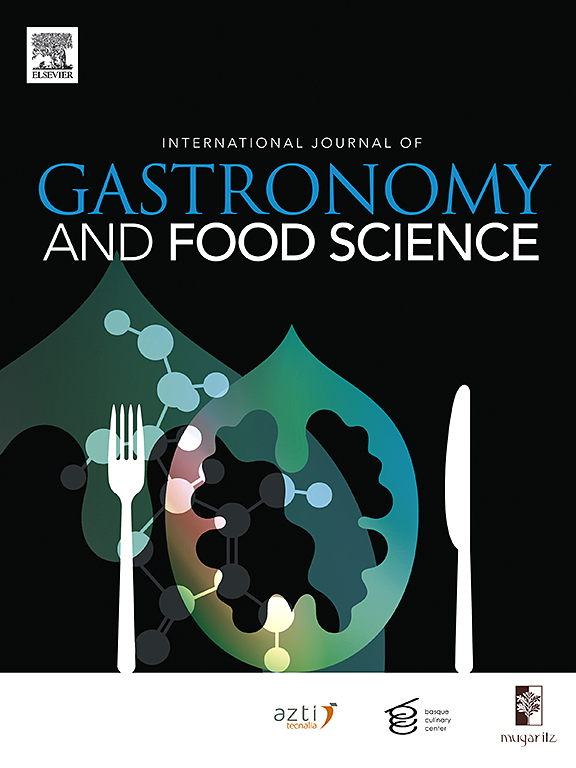Characterization of microbiological and physicochemical changes in traditional Thai pla ra during two-stage fermentation of snakehead fish (Channa striata)
IF 3.6
2区 农林科学
Q2 FOOD SCIENCE & TECHNOLOGY
International Journal of Gastronomy and Food Science
Pub Date : 2025-05-31
DOI:10.1016/j.ijgfs.2025.101214
引用次数: 0
Abstract
The present study examines the microbiological and physicochemical transformations occurring during the traditional fermentation of pla ra, an ethnic fermented fish product popular in northeastern Thailand (Isan region). Utilizing a two-stage fermentation process—initial salting of snakehead fish (Channa striata) for three months followed by the addition of rice bran for an additional three months—changes in microbial communities and biochemical properties were systematically analyzed. In the early stages of fermentation, halophilic bacteria such as Pediococcus and Tetragenococcus predominated, whereas the addition of rice bran promoted the growth of Lactobacillus in later stages. Fungal species, including Saccharomyces, Candida, and Aspergillus, exhibited increased abundance during the second stage, contributing to the flavor complexity and sensory profile of pla ra. Biochemical modifications observed during pla ra fermentation included a decline in pH, accumulation of protein and lipid degradation products, and increased lipid oxidation. Correlation analysis showed that Lactobacillus and Aspergillus were the most dominant microorganisms contributing to pH, protein hydrolysis, and lipid degradation during fermentation. All the microbial and biochemical processes induced physical changes, including softening of fish muscle and progressive browning of the product. A further organoleptic liking test using untrained panelists demonstrated that the incorporation of pla ra fermented with rice bran enhanced panelists’ acceptance of som tum, a traditional Thai green papaya salad. The findings generated from this study could serve as a foundation for further studies on pla ra and its integration into international culinary and scientific contexts.
传统泰式乌鳢两段发酵过程中微生物学和理化变化的研究
本研究考察了在泰国东北部(伊山地区)流行的民族发酵鱼产品pla的传统发酵过程中发生的微生物和物理化学转化。采用两阶段发酵工艺——先将黑头鱼(Channa striata)腌制3个月,再添加米糠3个月——系统地分析了微生物群落和生化特性的变化。发酵前期以嗜盐菌为主,如Pediococcus和tetragencoccus,而米糠的添加促进了后期乳杆菌的生长。真菌种类,包括酵母菌、念珠菌和曲霉,在第二阶段表现出增加的丰度,这有助于香蕉的风味复杂性和感官特征。在pla发酵过程中观察到的生化变化包括pH下降,蛋白质和脂质降解产物积累以及脂质氧化增加。相关分析表明,乳杆菌和曲霉是发酵过程中pH、蛋白质水解和脂质降解的最主要微生物。所有的微生物和生化过程都引起了物理变化,包括鱼肌肉的软化和产品的逐渐褐变。对未经训练的小组成员进行的进一步感官喜好测试表明,加入米糠发酵的pla增强了小组成员对传统泰国绿色木瓜沙拉som tum的接受度。这项研究的结果可以作为进一步研究pla及其融入国际烹饪和科学背景的基础。
本文章由计算机程序翻译,如有差异,请以英文原文为准。
求助全文
约1分钟内获得全文
求助全文
来源期刊

International Journal of Gastronomy and Food Science
Social Sciences-Cultural Studies
CiteScore
5.30
自引率
10.50%
发文量
170
审稿时长
45 days
期刊介绍:
International Journal of Gastronomy and Food Science is a peer-reviewed journal that explicitly focuses on the interface of food science and gastronomy. Articles focusing only on food science will not be considered. This journal equally encourages both scientists and chefs to publish original scientific papers, review articles and original culinary works. We seek articles with clear evidence of this interaction. From a scientific perspective, this publication aims to become the home for research from the whole community of food science and gastronomy.
IJGFS explores all aspects related to the growing field of the interaction of gastronomy and food science, in areas such as food chemistry, food technology and culinary techniques, food microbiology, genetics, sensory science, neuroscience, psychology, culinary concepts, culinary trends, and gastronomic experience (all the elements that contribute to the appreciation and enjoyment of the meal. Also relevant is research on science-based educational programs in gastronomy, anthropology, gastronomic history and food sociology. All these areas of knowledge are crucial to gastronomy, as they contribute to a better understanding of this broad term and its practical implications for science and society.
 求助内容:
求助内容: 应助结果提醒方式:
应助结果提醒方式:


